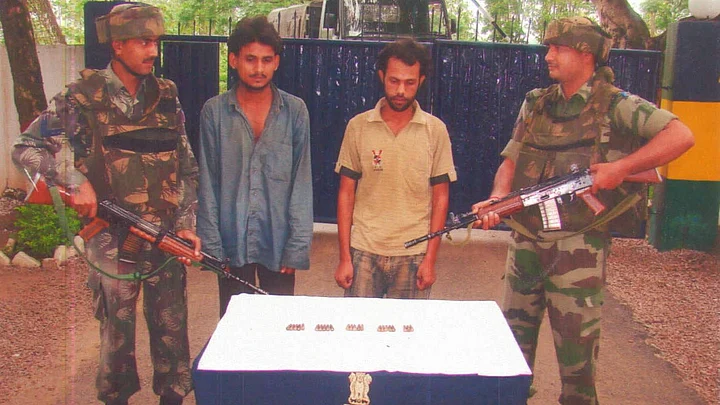Engagement of women has been a common phenomenon with ethnic insurgent groups in the Northeast and the Maoists in other regions of the country for the past several decades but extremely rare for Muslim jihadi outfits.
Among the many fascinating aspects of the recently busted module of Ansarullah Bangla Team (ABT) in Assam which is affiliated to the Al Qaeda in Indian Subcontinent (AQIS) was the unsuspecting role of a woman who was arrested for alleged links with the terror organisation. Jahura Khatun, aged 22, was arrested on 7 August from the border district of Dhubri in Bilasipara for being in possession of two mobile phones which were confiscated by the police out of which one was burned by her family members to eliminate evidences of links (with other members of the group).
Who is Jahura?
Jahura is the wife of absconding ABT activist Abu Tallah who operated out of Assam’s central district of Morigaon from where other functionaries of the outfit had also been arrested.
Briefing media persons, Dhubri SP Abhijit Gurav said “We have found some links between her (Jahura) and ABT. She has actively helped ABT cadres and has visited some training camps of the outfit at different places. There is digital evidence as well about which we will disclose later.”
Jahura is the second woman to have been arrested so far in Assam for links with jihadi outfits. The first was in 2014 when Suzena Begum was arrested in Guwahati for links with Jamaat-ul-Mujahideen Bangladesh (JMB) after the blast at Burdwan in West Bengal.
ABT Module Has New Features
An evaluation of the ABT module reveals how the tactics of jihadi outfits have evolved and become more sophisticated over the years unlike the separatist ethnic insurgents in the Northeast that continue to rely mostly on ambushes in the border districts.
It is not yet known if more women were enrolled by the ABT in Assam. The precise role of Jahura in the outfit is still under investigation but what appears to be a possibility was her assigned role of ‘coordination’ among the functionaries of the group. This also points to the fact that she had already been indoctrinated and found to be capable of accomplishing the tasks assigned to her.
ABT seems to have understood the advantages that women have over men in certain tasks and situations which were earlier evidenced from their roles with some insurgent outfits in the Northeast. Many rebel leaders in the region admitted that women were able to fulfil assignments on surveillance and information gathering better than their male counterparts.
Sometime in the late 90s, the ULFA had engaged women for some high-profile assassinations. Some of these attempts failed but a few were successful including that of a brigadier who was gunned down in the heart of Guwahati. Jahura was adept in the use of the ‘dark web’ for peer-to-peer communication through a sophisticated and expensive software. Gurav informed that she had also been trained to destroy evidence so that no information would be available to the police on the other members of the module. Incidentally, police are searching for some Bangladeshi nationals believed to have been actively involved with ABT in Assam.
All these tactics were unknown to the previous jihadi modules busted in Assam that operated more-or-less on the conventional pattern. Jamatul-ul Mujahideen Bangladesh (JMB), for instance, was structured unlike the ABT which is loosely organised and decentralised, according to some government officials.
Earlier Jihadi Modules In Assam
If some former rebels engaged with ethnic insurgent groups in Assam are to be believed, it was sometime in the mid-90s coinciding with the regime of the pro-Pakistan Bangladesh Nationalist Party (BNP) in Bangladesh that efforts were made by the Inter Services Intelligence (ISI) to explore the possibility of floating jihadi organisations in Assam.
A couple of outfits such as the Muslim United Liberation Tigers of Assam (MULTA) and Muslim United Liberation Force of Assam (MULFA) were formed with active linkages with the ISI. According to intelligence reports, some top functionaries from these groups were also taken to Bangladesh for indoctrination by the ISI.
MULFA fizzled out soon but MULTA was active for a while which was apparent from the arrests made occasionally in the state but without any impact.
The twin deficits of cadres and funds necessary to sustain rebel outfits ensured that these efforts met with a dead end within a few years. The claim in some books that more than 30 jihadi outfits were formed in the state in the nineties was based on doctored reports of Assam’s Special Branch by a senior officer which was not true.
Subsequently, the ISI decided to strengthen its ties with the ethnic insurgent outfits in the Northeast such as the ULFA and the NDFB which was established from the training organised for these and other groups at several locations along the Pakistan-Afghanistan border.
Assam's Difficult-to-Reach Islands Provide Safe Haven
Unlike the ties that existed between MULTA and the ISI and possibly a section of the Bangladesh’s intelligence agencies, there is no evidence so far to suggest that the ABT module was activated in Assam and other states of the country at the behest of these agencies. They were being instructed by their handlers from Bangladesh believed to be senior functionaries of the organisation. It is not yet known if they have links with intelligence agencies.
Another distinction between the earlier organisations and ABT was the latter’s choice of locations in Assam to strengthen the modules. Police have gathered evidence of ABT’s activities in two remote chars (riverine islands) of Dhubri which are extremely remote and difficult to reach. There are hundreds of such islands in the state where the government’s presence is either nil or minimum.
Sensing the danger, police had conducted a survey of 829 villages in char areas five years ago to bring them under surveillance and mitigate ‘security threats’ from across the border.
(Rajeev Bhattacharyya is a senior journalist in Guwahati. Views expressed are personal.)
